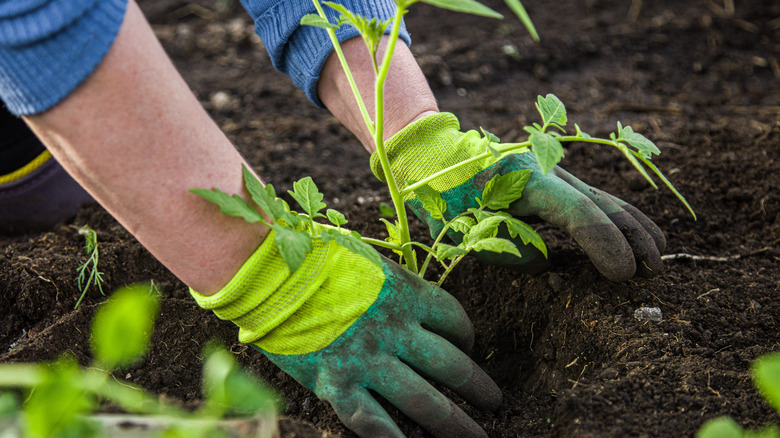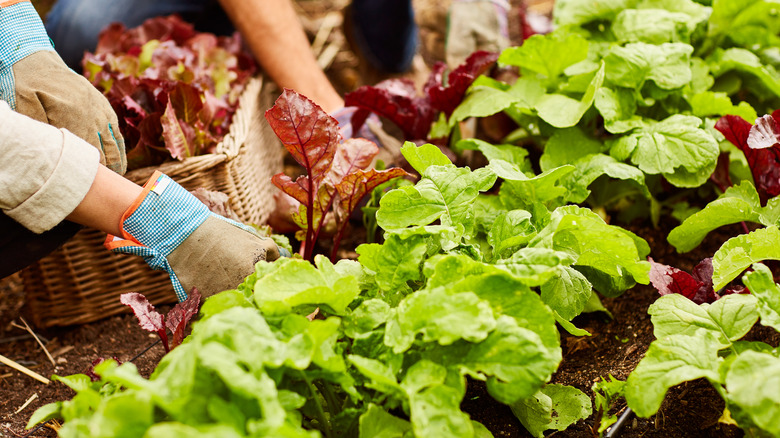The Top Three Easiest Foods To Grow In Your Garden, According To TikTok
For those of us who don't have green thumbs, gardens can actually be terrifying. Beyond the very real fear of accidentally overwatering or underwatering your plants for days on end, there's the ever-waking terror of pests getting to your garden before you can, leaving you with nothing as the next season approaches. Making the switch from beautiful flowers to food can be even more of a challenge. But what if we told you there was a gardening cheat code for anybody wanting to create a thriving food garden.
First things first, it's integral you grow some lemon balm or another citrus-type plant around your food plants. Beyond keeping spiders and other pests away, this will naturally ensure your garden smells amazing at all times. Then, TikTok user @perkyplantparent has highlighted three plants that will surely grow in anybody's garden: potato, tomato, and lettuce seedlings.
Potatoes are great for anyone who doesn't have much time on their hands because they have the natural drive to grow, regardless of human interaction. Tomatoes are also good because a little bit of water and fertilizer will always go a long way. And lettuce is perfect for those who may not have the best access to sunshine. Because they can grow in the shade and aren't considered a high-maintenance plant, adding this staple to your garden will ensure you have a thriving plant in as little as 30 days.
How to grow these plants properly
When it comes to potatoes, start this process by digging a hole in your garden that's about 6 to 8 inches deep. Either inside or outside works. Cut a piece of seed potato and place the cut side down into your trench. Try placing each potato cutting about 12 to 15 inches apart. If this isn't ideal for your small space, bringing them closer together is okay, too. If grown completely indoors, be sure your potatoes have access to sunlight. Even though they burrow underground, they need access to at least six hours of direct sunlight each day for a healthy growth cycle.
Tomatoes also love sunny conditions and desire about six to eight hours of direct sunlight. Water is also essential here. TikTok user @mindandsoil experienced a 100% germination rate by filling the small tomato pots with worm casting seed mix, then plenty of water. You'll want your soil to be extremely wet, so the seedling can be moistened immediately. After planting a few seeds into your small container, water it a bit more. Though the creator recommends using a grow light for definite growth, feel free to use direct sunlight, instead, if you have access.
Watering once or twice a day will be needed as temperatures increase. If you prefer to plant your tomatoes directly in the ground, they'll need a bit less water, but always around 1 to 2 inches a week.
The secrets to growing the perfect lettuce plant
Growing lettuce just may be the easiest of the bunch when it comes to those who suffer from a numb thumb. Begin in the spring or fall, as lettuce prefers weather conditions between 45 and 80 degrees. Start with well-drained, moist soil that is filled with organic matter. If you can, also be sure to check the pH balance is between 6.0 and 7.0. When the soil is over 7.0, this can lead to nutrients becoming unavailable to your plant during the growth cycle. If the soil isn't the safest, adding cottonseed or composted manure will ensure your home-grown lettuce thrives with ease.
Once your soil is ready to go, moisten the soil and sprinkle a few seeds. There is no exact science to lettuce seed placement, so do what feels right. The process takes about seven to 14 days to germinate and, most of the year, they'll naturally adapt to their spacing with full sun or grow perfectly in shade. That said, planting them in a spot with afternoon shade is a great rule of thumb for the summer. When it comes to watering, only hydrate your lettuce plant if the first inch of soil is dry. Considering the roots are so shallow, it needs to stay moistened, but be wary of a shifting water cycle as the seasons change. Summer definitely calls for a bit more water, as the sun is out for longer periods of the day.

